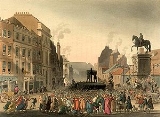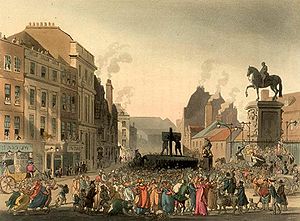
As I Was Going by Charing Cross
Encyclopedia
'As I Was Going By Charing Cross' is an English language
nursery rhyme
, sometimes referred to as 'As I was going to Charing Cross'. It has a Roud Folk Song Index
number of 20564.
 The rhyme is thought to refer to the equestrian statue of Charles I
The rhyme is thought to refer to the equestrian statue of Charles I
(r. 1625-49) which was erected after the Restoration
in 1660 and was moved in 1675 to the old Charing Cross
. The statue is largely dark in colour, but the 'black' may refer to the king's hair colour.
The last line may refer to the reaction of the crowd when he was beheaded, or it may be a puritan
satire on royalist reactions to the event. The rhyme may also have been produced out of a combination of existing couplets. A traditional London street cry was:
A note in a seventeenth-century manuscript at Oxford contains the lines:
The first part was printed as a children's rhyme in a variation of the more famous "Ride a Cock Horse" in Pretty Tales published in 1808, with the lyrics:
The modern version, which may combines elements of this rhyme with a reference to the execution of Charles I, was first collected and printed by James Orchard Halliwell in the 1840s.
English language
English is a West Germanic language that arose in the Anglo-Saxon kingdoms of England and spread into what was to become south-east Scotland under the influence of the Anglian medieval kingdom of Northumbria...
nursery rhyme
Nursery rhyme
The term nursery rhyme is used for "traditional" poems for young children in Britain and many other countries, but usage only dates from the 19th century and in North America the older ‘Mother Goose Rhymes’ is still often used.-Lullabies:...
, sometimes referred to as 'As I was going to Charing Cross'. It has a Roud Folk Song Index
Roud Folk Song Index
The Roud Folk Song Index is a database of 300,000 references to over 21,600 songs that have been collected from oral tradition in the English language from all over the world...
number of 20564.
Lyrics
Modern versions include:As I was going by Charing Cross,
I saw a black man upon a black horse;
They told me it was King Charles the First-
Oh dear, my heart was ready to burst!
Origin

Charles I of England
Charles I was King of England, King of Scotland, and King of Ireland from 27 March 1625 until his execution in 1649. Charles engaged in a struggle for power with the Parliament of England, attempting to obtain royal revenue whilst Parliament sought to curb his Royal prerogative which Charles...
(r. 1625-49) which was erected after the Restoration
English Restoration
The Restoration of the English monarchy began in 1660 when the English, Scottish and Irish monarchies were all restored under Charles II after the Interregnum that followed the Wars of the Three Kingdoms...
in 1660 and was moved in 1675 to the old Charing Cross
Charing Cross
Charing Cross denotes the junction of Strand, Whitehall and Cockspur Street, just south of Trafalgar Square in central London, England. It is named after the now demolished Eleanor cross that stood there, in what was once the hamlet of Charing. The site of the cross is now occupied by an equestrian...
. The statue is largely dark in colour, but the 'black' may refer to the king's hair colour.
The last line may refer to the reaction of the crowd when he was beheaded, or it may be a puritan
Puritan
The Puritans were a significant grouping of English Protestants in the 16th and 17th centuries. Puritanism in this sense was founded by some Marian exiles from the clergy shortly after the accession of Elizabeth I of England in 1558, as an activist movement within the Church of England...
satire on royalist reactions to the event. The rhyme may also have been produced out of a combination of existing couplets. A traditional London street cry was:
I cry my matches at Charing Cross,
Where sits a black man on a black horse.
A note in a seventeenth-century manuscript at Oxford contains the lines:
But because I cood not a vine Charlles the furste
By my toth my hart was readdy to burst
The first part was printed as a children's rhyme in a variation of the more famous "Ride a Cock Horse" in Pretty Tales published in 1808, with the lyrics:
Ride a Cock Horse,
To Charing Cross,
To see a black man,
Upon a black horse.
The modern version, which may combines elements of this rhyme with a reference to the execution of Charles I, was first collected and printed by James Orchard Halliwell in the 1840s.

